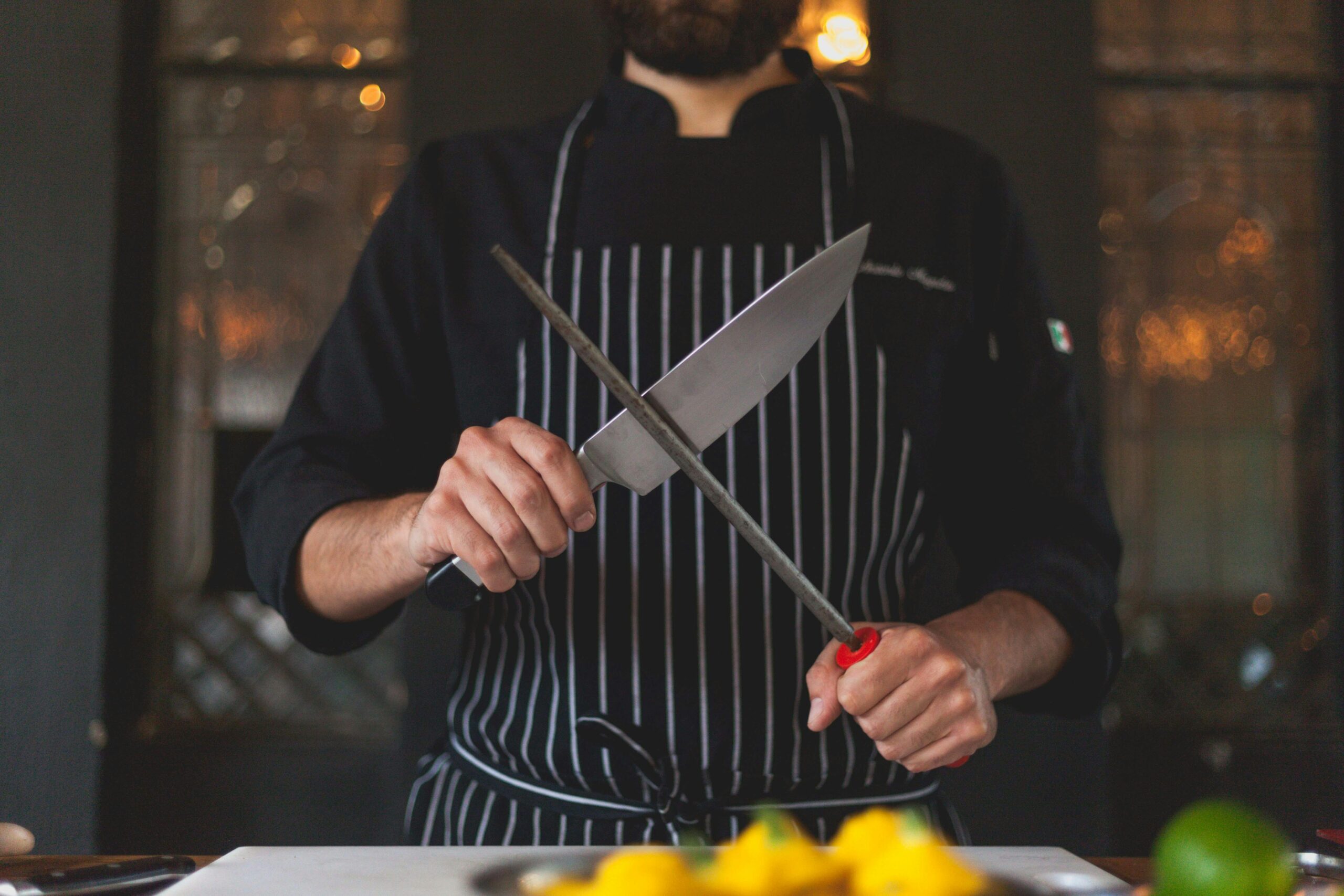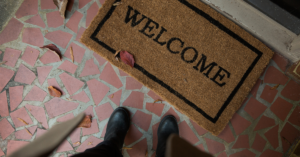Table of Contents
Why Keeping Your Knives Sharp is Essential
Safety
It may seem counterintuitive, but a dull blade requires more force to cut through materials, increasing the likelihood of slipping and causing accidental injuries.
Efficiency
Sharp knives make tasks easier and faster. Whether you’re slicing vegetables, carving meat, or dicing herbs, a sharp blade performs the job with precision and ease.
Longevity
Regular sharpening extends the life of your knives. By maintaining a sharp edge, you reduce the wear and tear on the blade, preventing unnecessary damage and prolonging its usability.
Understanding Knife Sharpener Types
Different sharpeners suit different needs and preferences. Here’s a detailed look at the most common types:
Manual Sharpeners
Manual sharpeners, also known as hand-held sharpeners, are simple tools that require no electricity. They usually feature a slot or V-shaped guides that hold the blade at the correct angle.
Pull-Through Sharpeners:
These have a fixed angle and are easy to use, making them ideal for beginners. They often come with multiple slots for coarse and fine sharpening.
Sharpening Rods/Sticks:
These are cylindrical rods, often made of ceramic or steel, that you manually slide the knife against.
Electric Sharpeners
Electric sharpeners offer convenience and speed. They come with motorized abrasive wheels that sharpen the knife as you pull it through the slots.
Two-Stage Sharpeners: These have a coarse wheel for initial sharpening and a fine wheel for honing.
Three-Stage Sharpeners: These include an additional stage for polishing the blade, resulting in a finer edge.
Whetstones
Whetstones, or sharpening stones, are blocks of abrasive material used for manual sharpening. They come in various grits, from coarse to fine, and require some skill to use effectively.
Water Stones: Require soaking in water before use.
Oil Stones: Lubricated with oil during sharpening.
Diamond Stones: Embedded with industrial diamonds for faster sharpening.
How to Use a Knife Sharpener
How to Use a Manual Knife Sharpener
Manual sharpeners are straightforward and effective. Follow these steps for optimal results:
Pull-Through Sharpeners
Select the Slot: Choose the coarse or fine slot based on your knife’s sharpness.
Position the Sharpener: Place the sharpener on a stable surface.
Insert the Knife: Hold the knife at the base of the blade, inserting it into the slot.
Pull the Knife: Draw the blade through the slot, applying even pressure. Repeat 3-5 times or as needed.
Switch to Fine Slot: If using a multi-stage sharpener, repeat the process in the fine slot for a polished edge.
Sharpening Rods
Hold the Rod: Hold the rod vertically with the tip resting on a stable surface.
Position the Knife: Hold the knife at a 20-degree angle to the rod.
Sharpen the Blade: Draw the blade down the rod in a sweeping motion, alternating sides. Repeat 5-10 times per side.
Test the Sharpness: Check the sharpness by slicing through paper or gently feeling the edge.
How to Use an Electric Knife Sharpener
Electric sharpeners are quick and efficient. Here’s a step-by-step guide:
Read the Manual: Follow the manufacturer’s instructions for your specific model.
Place the Sharpener: Set the sharpener on a stable surface and plug it in.
Insert the Knife: Place the blade into the coarse sharpening slot.
Pull the Knife: Slowly pull the blade through the slot, following the machine’s guides.
Switch Slots: Move to the fine or honing slot and repeat the process.
Test the Sharpness: Evaluate the blade’s sharpness and repeat if necessary.
How to Use a Whetstone
Whetstones offer precision and versatility. Here’s how to use them:
Soak or Lubricate the Stone: If using a water stone, soak it in water for 10-15 minutes. Oil stones should be lubricated with honing oil.
Position the Stone: Place the stone on a non-slip surface or a dedicated stone holder.
Find the Angle: Hold the knife at the correct sharpening angle, usually around 20 degrees for kitchen knives.
Blade Sharpen: Maintaining proper angle, sharp the blade. Repeat on both sides of the blade.
Refine the Edge: Switch to a finer grit stone to polish and refine the edge.
Test the Sharpness: Carefully test the sharpness by slicing through a piece of paper or gently running your thumb across the edge (without touching it directly).
Knife Maintenance Tips
Proper maintenance is essential for keeping your knives sharp and in good condition. Some tips are given below:
Cleaning
Always clean your knives after use to prevent food residue and moisture from damaging the blade. Use hand wash, soap water and dry as soon as possible.
Storage
Store your knives in a knife block, magnetic strip, or blade guard to protect the edge. Avoid storing knives loose in a drawer, as this can cause damage.
Regular Honing
Use a honing rod regularly to maintain the edge between sharpening sessions. This will help prolong the time between full sharpenings.
Avoiding Hard Surfaces
Cutting on hard surfaces like glass, stone, or metal can dull your knife quickly. Use a wooden or plastic cutting board to preserve the edge.
Proper Use
Use your knives for their intended purpose. Avoid using them to cut hard materials like bones, frozen foods, or as a screwdriver or pry bar.
Troubleshooting Common Sharpening Issues
Even with the best techniques, you may encounter some common issues while sharpening your knives. Here’s how to troubleshoot them:
Uneven Edge
An uneven edge can result from inconsistent pressure or angle while sharpening. To fix this, focus on maintaining a consistent angle and pressure throughout the process.
Burr Formation
A burr is a thin, raised edge of metal that forms during sharpening. It’s a sign that the edge is being sharpened but needs to be removed for a clean finish. Use a finer grit stone or a honing rod to remove the burr.
Dull Spots
Dull spots can occur if certain areas of the blade are not being sharpened evenly. Pay extra attention to these areas, ensuring consistent contact with the stone or sharpening tool.
Chipping
Chipping can result from using a blade that is too hard or from improper sharpening techniques. If your knife chips, try using a coarser stone to remove the damaged edge and then refine it with finer stones.
Advanced Sharpening Techniques
For those looking to take their sharpening skills to the next level, here are some advanced techniques:
Mirror Polishing
Mirror polishing involves using very fine grit stones or polishing compounds to achieve a mirror-like finish on the edge. This technique is often used for straight razors and high-end kitchen knives.
Convex Sharpening
Convex sharpening requires a special technique to create a rounded edge. It’s typically done with a slack belt sander or by freehand sharpening with a rolling motion on a whetstone.
Reprofiling
Reprofiling involves changing the angle or shape of the blade edge. This technique is useful for customizing the performance of a knife or repairing significant damage. It requires coarse stones and careful attention to detail.
Conclusion
Using a knife sharpener effectively is a valuable skill that enhances your kitchen efficiency and safety. By understanding the different types of sharpeners, mastering the techniques for each, and maintaining your knives properly, you can ensure your blades remain in top condition. Whether you prefer the simplicity of manual sharpeners, the speed of electric models, or the precision of whetstones, the key is to practice and find what works best for you. With regular sharpening and proper care, your knives will serve you well for years to come.
FAQs
1. What types of knife sharpeners are available?
There are several types of knife sharpeners including manual sharpeners, electric sharpeners, and whetstones. Each type has its own method of sharpening and is suitable for different needs and preferences.
2. How do I use a manual knife sharpener?
To use a manual pull-through sharpener, place it on a stable surface, insert the knife into the appropriate slot (coarse or fine), and pull the blade through while applying even pressure. Repeat as needed and test the sharpness afterward.
3. How do I use an electric knife sharpener?
Plug in the electric sharpener, insert the knife into the coarse sharpening slot, and slowly pull the blade through following the machine’s guides. Repeat the process in the fine or honing slot, then test the sharpness.
4. How do I use a whetstone?
Soak a water stone or lubricate an oil stone before use. Place the stone on a stable surface, hold the knife at a 20-degree angle, and slide the blade across the stone in a sweeping motion. Repeat on both sides and switch to a finer grit stone to refine the edge.
5. How often should I sharpen my knives?
It depends on usage, but for regular kitchen use, hone the knife with a rod every few uses and sharpen it every few months.
6. What is the best angle for sharpening a knife?
The optimal angle for sharpening most kitchen knives is between 15-20 degrees. Outdoor and utility knives typically require a 20-25 degree angle for durability.
7. Can I sharpen serrated knives with a knife sharpener?
Yes, but you need a sharpener specifically designed for serrated knives or a ceramic rod to sharpen each serration individually.
8. What grit of whetstone should I use for sharpening?
Use a coarse grit (200-600) for dull knives or repairing damage, medium grit (800-2000) for general sharpening, and fine grit (3000-8000) for polishing and achieving a razor-sharp edge.
9. How do I know if my knife is sharp enough?
Test the sharpness by slicing through paper or gently running your thumb across the edge (without touching it directly). A sharp knife should easily cut through paper and feel smooth.
10. Why does my knife feel dull after sharpening?
If your knife feels dull after sharpening, you may not have maintained a consistent angle, applied uneven pressure, or fully removed the burr. Ensure proper technique and consider using a finer grit stone or honing rod.
11. Is honing the same as sharpening?
No, honing realigns the edge of the knife, keeping it sharp between sharpening sessions. Sharpening involves grinding away material to create a new edge, restoring the blade’s sharpness.
12. Can I use household items to sharpen a knife?
In emergencies, you can use the unglazed bottom of a ceramic mug or a smooth stone, but these methods are not recommended for regular use as they can damage the knife.
13. Do I need different sharpeners for different knives?
Different knives may benefit from specific sharpeners. Whetstones are versatile, while serrated knives require specialized sharpeners. Electric sharpeners often have settings for various knife types.
14. What should I do if my knife has a burr after sharpening?
Use a finer grit stone or a honing rod to gently remove the burr. .
15. Is it worth getting a professional knife sharpener?
If you have high-quality knives or lack confidence in your sharpening skills, professional sharpening can ensure optimal results and extend the life of your blades.




I’ll immediately clutch your rss feed as I can’t to find your email
subscription hyperlink or e-newsletter service.
Do you’ve any? Kindlky let me realize so that I may subscribe.
Thanks. https://bandur-ART.Blogspot.com/2024/08/the-ultimate-guide-to-no-mans-sky-mods.html
I’ll immediately clutch your rss feed as I can’t to
find your email subscription hyperlink or e-newsletter service.
Do you’ve any? Kindly let mee realiize so that I mayy subscribe.
Thanks. https://bandur-ART.Blogspot.com/2024/08/the-ultimate-guide-to-no-mans-sky-mods.html
primer-8
Get verified accounts easily at ToMyAccount.com. We provide PVA accounts that are created using unique IPs, ensuring they work seamlessly on any platform. Our fast delivery and secure transactions make buying accounts simple and stress-free. Visit us today to explore your options.
Explore the Site:
https://ToMyAccount.com
Cheers!
Ивенты в клубах порадуют вам интерактивные эмоции. Рок-фестивали раскрывают погрузиться. Мастер-классы каждый раз оставляют яркие воспоминания. Готовьте программу для лучших ивентов в кругу друзей!
Купить билеты на ближайшие театральные события
Выбор №1 для покупки продукции Microsoft, с отличными отзывами.
microsoft power platform [url=https://www.best-lip-filler.com]https://www.best-lip-filler.com[/url] .
Развлечения на выходных наполнят вам интересные переживаний. Посещение ресторанов обогатят вас поймать ритм жизни. Зимние развлечения вдохновляют запоминающиеся встречи. Бронируйте свои активности с удовольствием!
gravatar.com/mapmasteronline
Развлечения на танцполах дадут море вам огромное количество переживаний. Прогулки на велосипеде позволят расслабиться. Клубные вечеринки зазывают на зажигательные минуты веселья. Планируйте с друзьями свои выходные с семьей спокойно и уверенно!
mapkartarossii.ru
Double glazed windows: the perfect solution for Melbourne
european windows http://www.bestnosefiller.com/windows/upvc-tilt-turn-windows .
Play on the most popular Lineage 2 servers
new server L2 https://www.cryptoexlicense.com/ .
Комнатные растения могут не только придавать стиль, но и защищать от аллергенов. Съедобные растения отлично подходят для украшения дома. Выбирая растения, учитывайте их устойчивость к засухе. Создавайте условия для быстрого роста.
Оливковое дерево естественные
Фруктовые деревья компактные.
Приятно узнать что-то новое.
https://pozdravnadr.ru/
Возможно, вы правы
https://pozdravnadr.ru/
Допускаю, что вы верно рассуждаете
eventjunction.ru
Вероятно, вы не ошибаетесь
eventjunction.ru
Hello.
Good cheer to all on this beautiful day!!!!!
Good luck 🙂
Why are domestic animals so important, why people love pets.
How to choose a pet, advantages of different pet breeds.How to properly care for pets, how to create a pet’s diet.Interesting facts about pets, why people adore pets.effective methods of pet training, how to train a cat to walk on a leash.
all domestic animals name https://petstorepetsupply.com/index.php/2024/06/01/companion-planting-tips/ .
Лучшие базы для Xrumer и GSA Search Engine Ranker по самым лучшим ценам
https://dseo24.monster
Онлайн магазин баз для Xrumer и GSA лучшие цены
Безупречный игровой сайт Лев предлагает для вас потрясающие опции для ярких побед!
На площадке Лев вас ждут акционные игры и огромное количество игр. Каждый раз здесь вы сможете завоевать множество призов с легкостью и удовольствием!
Площадка Лев предлагает эксклюзивные акции, которые улучшают ваш игровой процесс. Примите участие в лотереях, чтобы достичь успеха.
Наш сайт обеспечивает интуитивно понятный интерфейс, обеспечивает легкость использования на любом устройстве.
На игровом доме Лев вас ожидают не только видеослоты, но и живые игры, которые обеспечат вам ощутить азарт вживую прямо у себя дома.
Кроме того, наш кэшбэк предложат вам фриспины на регулярной основе.
Играй с удовольствием, побеждай с Lev, и добивайся призов каждый день!
На платформе Лев вас ждут выгодные предложения и разнообразие игровых автоматов. Каждый раз здесь вы попробуете получить колоссальные суммы.
Зарегистрируйтесь на нашем сайте и начните побеждать игровые автоматы уже без промедлений! казино лев, faq, правила, бонус
казино лев 2024
Car rental with a driver for any occasion
rent premium car dubai https://trafficarbitration.com/ .
The history of command coins, and why they are so valued by collectors.
The best places to acquire commander coins, to steer clear of fraudsters.
best challenge coin company https://command-coins.com/ .